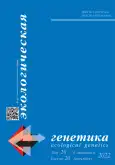Genetically modified yeasts in studies of human amyloidosis
- Authors: Kulichikhin K.Y.1, Zelinsky A.A.1, Gorsheneva N.A.1, Ryabinina M.V.1, Grizel A.V.1, Azarov V.V.1, Rubel A.A.1
-
Affiliations:
- Saint Petersburg State University
- Issue: Vol 20 (2022): Supplement
- Pages: 50-51
- Section: Genetically modified organism. The Нistory, Achivements, Social and Environmental Riscs
- Submitted: 03.11.2022
- Accepted: 09.11.2022
- Published: 08.12.2022
- URL: https://journals.eco-vector.com/ecolgenet/article/view/112321
- DOI: https://doi.org/10.17816/ecogen112321
- ID: 112321
Cite item
Full Text
Abstract
Amyloid protein aggregation is a key factor in the development of a variety of serious diseases in humans, commonly named as amyloidoses (Alzheimer’s and Parkinson’s diseases, type II diabetes, etc.), and a determinant of protein-based inheritance in lower eukaryotes. In yeast, translation termination factor Sup35 is one of the most extensively studied amyloidogenic proteins. Aggregation of Sup35 (induction of [PSI+] prion) decreases its functional activity and leads to the suppression of nonsense-mutation as stop-codons become recognized as meaningful more frequently. This phenomenon is the basis of phenotypic detection of Sup35 aggregation in yeast strains possessing nonsense mutation ade1-14 in ADE1 gene.
Yeast is convenient model for genetic, biochemical and molecular biology studies. Yeast genome can be easily edited and plasmids can be used for induction of gene expression. Yeast is suitable for analysis of mammalian genes and proteins and thus can be applied for the analysis of amyloidogenic properties of proteins associated with human diseases. Phenotyping detection of [PSI+] prion can be modified for the analysis of amyloid aggregation of mammalian proteins in yeast.
We use genetically modified yeasts Saccharomyces cerevisiae adopted for amyloid biology research. The mutations leading to auxotrophy toward certain amino acids (leucine, lysine, tryptophane, histidine) and nucleobases (adenine, uracil) were implemented into yeast genome allowing phenotyping detection of [PSI+] and the usage of plasmids for the investigation of mammalian protein in yeast.
Application of yeast-based experimental system for studies of different aspects of human amyloidoses is discussed.
This study was supported by Saint Petersburg State University (project 93025998).
Full Text
Amyloid protein aggregation is a key factor in the development of a variety of serious diseases in humans, commonly named as amyloidoses (Alzheimer’s and Parkinson’s diseases, type II diabetes, etc.), and a determinant of protein-based inheritance in lower eukaryotes. In yeast, translation termination factor Sup35 is one of the most extensively studied amyloidogenic proteins. Aggregation of Sup35 (induction of [PSI+] prion) decreases its functional activity and leads to the suppression of nonsense-mutation as stop-codons become recognized as meaningful more frequently. This phenomenon is the basis of phenotypic detection of Sup35 aggregation in yeast strains possessing nonsense mutation ade1-14 in ADE1 gene.
Yeast is convenient model for genetic, biochemical and molecular biology studies. Yeast genome can be easily edited and plasmids can be used for induction of gene expression. Yeast is suitable for analysis of mammalian genes and proteins and thus can be applied for the analysis of amyloidogenic properties of proteins associated with human diseases. Phenotyping detection of [PSI+] prion can be modified for the analysis of amyloid aggregation of mammalian proteins in yeast.
We use genetically modified yeasts Saccharomyces cerevisiae adopted for amyloid biology research. The mutations leading to auxotrophy toward certain amino acids (leucine, lysine, tryptophane, histidine) and nucleobases (adenine, uracil) were implemented into yeast genome allowing phenotyping detection of [PSI+] and the usage of plasmids for the investigation of mammalian protein in yeast.
Application of yeast-based experimental system for studies of different aspects of human amyloidoses is discussed.
This study was supported by Saint Petersburg State University (project 93025998).
About the authors
Konstantin Yu. Kulichikhin
Saint Petersburg State University
Author for correspondence.
Email: konstantin_kulichikhin@yahoo.com
SPIN-code: 6432-4970
PhD, Senior Researcher, Laboratory of Amyloid Biology
Russian Federation, Saint PetersburgAndrew A. Zelinsky
Saint Petersburg State University
Email: andrew_zelinsky@mail.ru
M.Sci. (Biology), Researcher, Laboratory of Amyloid Biology
Russian Federation, Saint PetersburgNatalia A. Gorsheneva
Saint Petersburg State University
Email: natalia.gorsheneva@mail.ru
SPIN-code: 4078-0275
M.Sci. (Biology), Engineer, Laboratory of Amyloid Biology
Russian Federation, Saint PetersburgMarina V. Ryabinina
Saint Petersburg State University
Email: marina.v1205@gmail.com
B.Sci. (Biology), Laboratory Assistant, Laboratory of Amyloid Biology
Russian Federation, Saint PetersburgAlexey V. Grizel
Saint Petersburg State University
Email: alexgrizel@gmail.com
Engineer, Laboratory of Amyloid Biology
Russian Federation, Saint PetersburgVladimir V. Azarov
Saint Petersburg State University
Email: st096374@student.spbu.ru
Undergraduate Student, Faculty of Biology
Russian Federation, Saint PetersburgAleksandr A. Rubel
Saint Petersburg State University
Email: arubel@mail.ru
SPIN-code: 3961-4690
PhD, The Head of the Laboratory, Laboratory of Amyloid Biology
Russian Federation, Saint PetersburgReferences
Supplementary files










